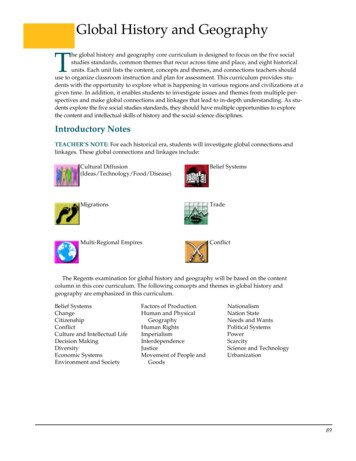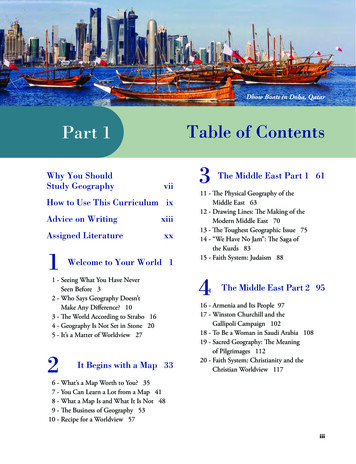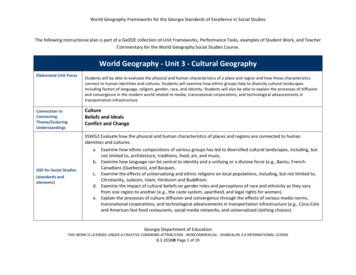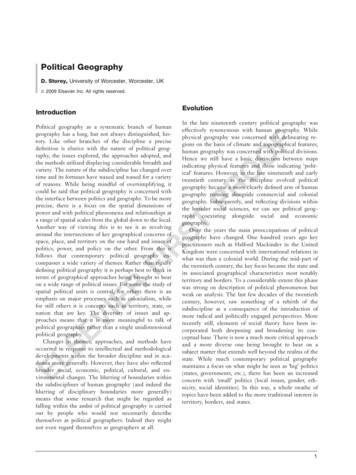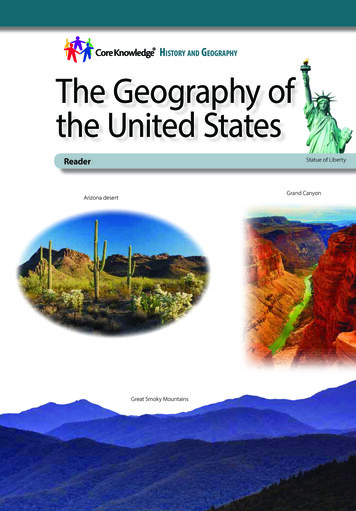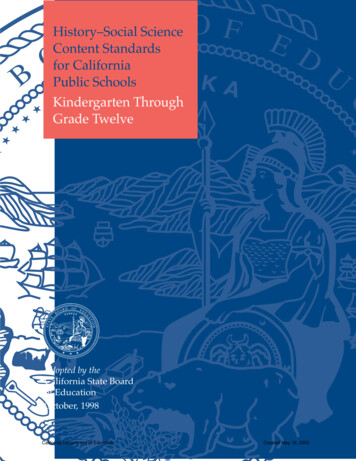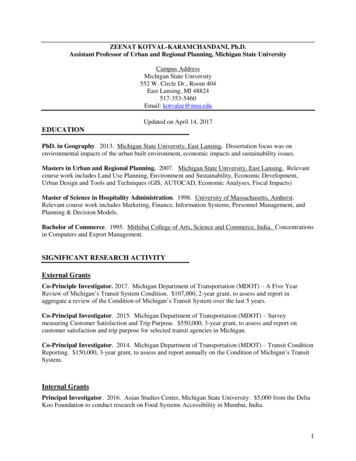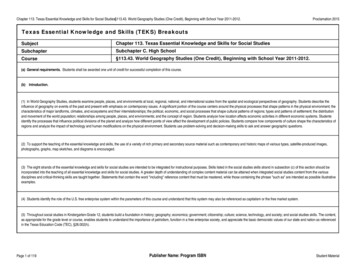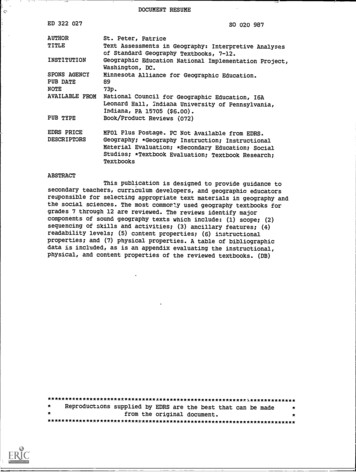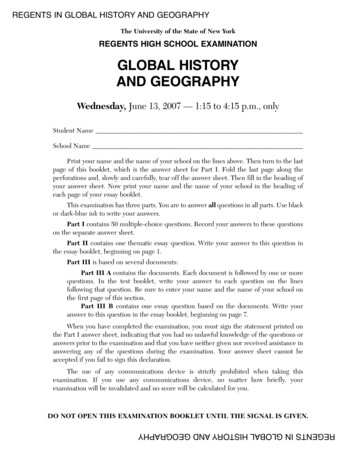
Transcription
REGENTS IN GLOBAL HISTORY AND GEOGRAPHYThe University of the State of New YorkREGENTS HIGH SCHOOL EXAMINATIONGLOBAL HISTORYAND GEOGRAPHYWednesday, June 13, 2007 — 1:15 to 4:15 p.m., onlyStudent NameSchool NamePrint your name and the name of your school on the lines above. Then turn to the lastpage of this booklet, which is the answer sheet for Part I. Fold the last page along theperforations and, slowly and carefully, tear off the answer sheet. Then fill in the heading ofyour answer sheet. Now print your name and the name of your school in the heading ofeach page of your essay booklet.This examination has three parts. You are to answer all questions in all parts. Use blackor dark-blue ink to write your answers.Part I contains 50 multiple-choice questions. Record your answers to these questionson the separate answer sheet.Part II contains one thematic essay question. Write your answer to this question inthe essay booklet, beginning on page 1.Part III is based on several documents:Part III A contains the documents. Each document is followed by one or morequestions. In the test booklet, write your answer to each question on the linesfollowing that question. Be sure to enter your name and the name of your school onthe first page of this section.Part III B contains one essay question based on the documents. Write youranswer to this question in the essay booklet, beginning on page 7.When you have completed the examination, you must sign the statement printed onthe Part I answer sheet, indicating that you had no unlawful knowledge of the questions oranswers prior to the examination and that you have neither given nor received assistance inanswering any of the questions during the examination. Your answer sheet cannot beaccepted if you fail to sign this declaration.The use of any communications device is strictly prohibited when taking thisexamination. If you use any communications device, no matter how briefly, yourexamination will be invalidated and no score will be calculated for you.DO NOT OPEN THIS EXAMINATION BOOKLET UNTIL THE SIGNAL IS GIVEN.REGENTS IN GLOBAL HISTORY AND GEOGRAPHY
Part IAnswer all questions in this part.Directions (1– 50): For each statement or question, write on the separate answer sheet the number of theword or expression that, of those given, best completes the statement or answers the question.Base your answer to question 1 on the map below and on your knowledge of social studies.AT L A N T I COCEANEURO PEASIAIndus RiverTigrisEuphrates RiverRiverNileRiverHuang He RiverChinaIndiaA ra b i aAFRI CAPA C I F I COCEANINDIANOCEANNWESSource: Charles F. Gritzner, Exploring Our World, Past and Present, D. C. Heath and Company (adapted)1 The main purpose of this map is to illustrate the location of(1) overseas trade routes(3) river valley civilizations(2) early belief systems(4) burial sites of ancient rulers2 Which social scientist specializes in studyingissues such as the scarcity of resources andavailability of goods?(1) anthropologist(3) economist(2) sociologist(4) archaeologist6 Which belief is most closely associated with thephilosophy of Confucianism?(1) nirvana(3) prayer(2) reincarnation(4) filial piety7 What was one result of large armies travelinggreat distances during the Crusades?(1) Europe’s population severely declined.(2) Democracy in the Middle East grew.(3) Cultural diffusion increased.(4) Slavery was eliminated.3 Which feature would most likely be shown on aphysical map?(1) population density(3) climate(2) vegetation zones(4) mountain ranges4 Which society practiced direct democracy?(1) ancient Athens(3) Gupta Empire(2) dynastic China(4) early Egypt8 Constantinople was a thriving city in the 1200smainly because of its location on a major traderoute between(1) China and southern Africa(2) the Atlantic Ocean and the Baltic Sea(3) the Inca Empire and the Aztec Empire(4) Asia and eastern Europe5 The caste system in India was characterized by(1) toleration for various religious beliefs(2) equality between men and women(3) a lack of social mobility(4) the right of people to choose their occupationsGlobal Hist. & Geo. – June ’07[2]
Base your answer to question 9 on the pictures below and on your knowledge of social studies.9 These architectural achievements best indicate that(1) advanced technology existed in early civilizations(2) religion was of little importance(3) entertainment was important to these ancient societies(4) trade routes existed between China and the AmericasBase your answer to question 10 on the map below and on your knowledge of social studies.Silk Routes, c. ongTamraliptiINDIAArabianSeaSadaCapitalSouth CityTemalaChina town/cityMajorSeaSilk RoadBay of BengalSource: Asian History on File, Facts on File, The Diagram Group (adapted)10 This map shows that the Silk Road(1) crossed both Africa and Asia(2) was located primarily in AsiaGlobal Hist. & Geo. – June ’07(3) followed a single route(4) started in Khotan[3][OVER]
Base your answer to question 11 on the map below and on your knowledge of social studies.West Africa, 800–1500AtlanticOceanMediterranean niElminato Por tugalGulf ofGuineaCitySalt sourceSaltGoldGold sourceDirection oftradeTraderouteSource: Patrick K. O’Brien, ed., Oxford Atlas of World History, Oxford University Press (adapted)11 Based on the map, which conclusion can best be drawn about this region?(1) The Sahara Desert acted as a barrier to trade.(2) Rivers served as the primary trade routes for the entire region.(3) The economy of the region was influenced by extensive trade connections.(4) Goods from the Gulf of Guinea were exchanged directly with English cities.12 The terms Bushido, samurai, and daimyo aremost closely associated with which group inJapanese history?(1) emperors(3) peasants(2) warriors(4) merchantsGlobal Hist. & Geo. – June ’0713 In 1453, the Ottoman Empire rose to power bydefeating the(1) Holy Roman Empire (3) Byzantine Empire(2) European crusaders (4) Mongol invaders[4]
17 One contribution that John Locke made toEnlightenment philosophy was the idea that(1) absolute monarchies should continue(2) the punishment should fit the crime(3) individual rights should be denied(4) governments should be based on the consentof the peopleBase your answers to questions 14 and 15 on themap below and on your knowledge of social studies.AB18 What was a major result of the GloriousRevolution?(1) Napoleon was restored to power.(2) England further limited its monarchy.(3) Oliver Cromwell became the leader ofEngland.(4) The Spanish Armada was defeated.CLatinAmerica19 A study of the revolutions in Latin America in the19th century would show that(1) religion was a major cause of the conflicts(2) Spanish-born peninsulares led most of theLatin American uprisings(3) nationalism had little influence on theoutcome(4) events in North America and Europeinfluenced Latin AmericansDNWESSource: American History, Historical Outline Map Book,Prentice Hall (adapted)20 A major reason the Industrial Revolution beganin England was that England possessed(1) a smooth coastline(2) abundant coal and iron resources(3) many waterfalls(4) numerous mountain ranges14 Which letter identifies the region in the AndesMountains where many Inca settlements werelocated?(1) A(3) C(2) B(4) D15 The letter C indicates an area of Latin Americathat was colonized mostly by the(1) Dutch(3) English(2) Portuguese(4) French21 What was an immediate result of the massstarvation in Ireland in the late 1840s?(1) expansion of the Green Revolution to Ireland(2) acceptance of British rule by the Irish(3) migration of many Irish to other countries(4) creation of a mixed economy in Ireland16 Pope Leo authorizes the sale of indulgences,1515 Martin Luther posts the Ninety-five Theses,151722 Which individual is associated with the phraseblood and iron as related to the unification ofGermany?(1) Otto von Bismarck(2) Giuseppe Garibaldi(3) Kaiser Wilhelm II(4) Count Camillo di CavourThese events are most closely associated with the(1) Protestant Reformation(2) Crusades(3) Age of Reason(4) Puritan RevolutionGlobal Hist. & Geo. – June ’07[5][OVER]
Base your answer to question 28 on the map belowand on your knowledge of social studies.23 Which statement would Social Darwinists mostlikely support?(1) Universal suffrage is a basic human right.(2) Political equality strengthens the effectiveness of government.(3) Stronger groups have the right to rule andcontrol weaker groups.(4) Public education should be guaranteed to allmembers of a society.1937–1938USSRSakhalinIsland24 One similarity between the Sepoy Mutiny andthe Boxer Rebellion is that they(1) opposed European imperialism(2) ended an established dynasty(3) resulted in the redistribution of land(4) instituted communist okyo25 What was a direct result of World War I?(1) Nicholas II was named czar of Russia.(2) Germany lost its colonies in Africa and Asia.(3) Archduke Franz Ferdinand was assassinatedby a terrorist.(4) The Ottoman Empire expanded.NankingWuhan on26 Which statement about both the BolshevikRevolution in Russia and the rise of fascism inGermany and Italy is accurate?(1) Economic conditions led to political change.(2) Industrialization hindered national development.(3) Goals were achieved by peaceful means.(4) Communist ideals fueled both movements.Source: Peter Stearns et al.,World Civilizations: The Global Experience,Pearson Longman (adapted)28 What is the best title for this map?(1) Dominance of Manchukuo(2) Japanese Imperial Expansion(3) East Asian Trade Routes(4) Natural Resources of China and Japan27 The term appeasement is best defined as(1) an attempt to avoid conflict by meeting thedemands of an aggressor(2) a period of peace and prosperity, resulting incultural achievement(3) a declaration of war between two or morenations(4) an agreement removing economic barriersbetween nationsGlobal Hist. & Geo. – June ’07RyukyuIslands29 “Mussolini Attacks Ethiopia” (1935)“Germany Takes the Rhineland Back” (1936)“Germany and Russia Divide Poland” (1939)These headlines might be used to illustrate theweakness of the(1) United Nations(3) Warsaw Pact(2) Congress of Vienna (4) League of Nations[6]
Base your answer to question 30 on the time line below and on your knowledge of social studies.19651972Second war overKashmir begins.Cease-firesigned.194919711992Cease-fire in Kashmirends 1st war indu mob destroys mosqueat Ayodhya, beginsHindu-Muslim riots.30 Which nations have been most directly involved in the events illustrated in this timeline?(1) Mongolia and China(3) Burma and Thailand(2) India and Pakistan(4) Cambodia and Laos34 Mikhail Gorbachev’s reforms of perestroika andglasnost resulted in(1) an era of world peace and Soviet prosperity(2) conditions that helped lead to the breakup ofthe Soviet Union(3) a successful transition to a commandeconomy in Russia(4) censorship of the news media in Russia31 Which communist nation is most closelyassociated with the leadership of Ho Chi Minhand the surrender of Saigon?(1) North Korea(2) Soviet Union(3) Vietnam(4) People’s Republic of China32 A similarity between the Polish group Solidarityin 1980 and the Chinese protesters in TiananmenSquare in 1989 is that both groups(1) supported movements for democracy(2) succeeded in ending communism(3) encouraged military occupation by the SovietUnion(4) favored increases in military spending35 The governments of Augusto Pinochet, SaddamHussein, and Slobodan Milosevic are examples of(1) absolute monarchies(2) oppressive regimes(3) democratic republics(4) Islamic theocracies36 One way in which wars, religious conflict, andnatural disasters are similar is that thesesituations may result in(1) the mass migration of people(2) economic stability(3) an increase in life expectancy(4) global warming33 The status of Hong Kong changed in July 1997when the city(1) was returned to China(2) was closed to international trade(3) became an independent nation(4) adopted a capitalist economyGlobal Hist. & Geo. – June ’07[7][OVER]
Base your answers to questions 37 and 38 on thepassage below and on your knowledge of socialstudies.Base your answers to questions 40 and 41 on thecartoon below and on your knowledge of socialstudies. . . Above all, we want equal political rights,because without them our disabilities will bepermanent. I know this sounds revolutionary tothe Whites in this country, because the majorityof voters will be Africans. This makes the Whiteman fear democracy.But this fear cannot be allowed to stand in theway of the only solution which will guaranteeracial harmony and freedom for all. It is not truethat the enfranchisement [right to vote] of all willresult in racial domination. Political division,based on colour, is entirely artificial and, when itdisappears, so will the domination of one colourgroup by another. The ANC [African NationalCongress] has spent half a century fightingagainst racialism. When it triumphs it will notchange that policy. . . .Source: Jeff Koterba, Omaha World Herald, 2003 (adapted)40 What is the main idea of this 2003 cartoon?(1) There are problems to resolve on the road topeace.(2) Colin Powell has removed the stumblingblocks to peace.(3) Both groups have reached agreement on theroad map for peace.(4) The road to peace has been carefullymapped.— Nelson Mandela, Speech at Rivonia Trial, 196437 This passage describes the opposition of theAfrican National Congress to the(1) revival of colonialism(2) rivalries between tribes(3) practice of apartheid(4) introduction of a coalition government41 This 2003 cartoon illustrates the strugglebetween Palestinians and(1) Iraqis(3) Egyptians(2) Hamas(4) Israelis38 Which generalization can be supported by thispassage?(1) Racism has disappeared in South Africa.(2) The African National Congress has changedits social goals.(3) Giving the vote to black Africans will result inracial domination.(4) Nelson Mandela opposed political divisionbased on color.42 Which heading best completes the partial outlinebelow?I.A. Unification of ItalyB. Formation of the Indian NationalCongressC. Founding of the Muslim LeagueD. Breakup of Austria-Hungary39 Kim Jong Il and Fidel Castro are 21st-centuryleaders who believe in the ideas of(1) Karl Marx(2) Adam Smith(3) Siddhartha Gautama(4) Jean-Jacques RousseauGlobal Hist. & Geo. – June ’07(1)(2)(3)(4)[8]Tensions of the Cold WarEffects of NationalismCauses of World War IIResults of Economic Revolutions
43 A.B.C.D.CrusadesFall of the Roman EmpireGolden Age of GreeceRenaissanceBase your answer to question 47 on the cartoonbelow and on your knowledge of social studies.Capitalism Will Crush Russia!Which sequence of letters places these events inthe correct chronological order?(1) A B C D(2) D C B A(3) C B A D(4) C D B ATO44 One way in which Asoka, Mansa Musa, andSuleiman the Magnificent are similar is that they(1) established republics(2) led nationalist movements(3) ruled during times of prosperity(4) discouraged scientific advancementsNABase your answers to questions 45 and 46 on thepassage below and on your knowledge of socialstudies.Source: Student Artwork, Shaneekwa Miller,Fashion Industries High School (adapted). . . The power of God can be felt in a momentfrom one end of the world to the other: the royalpower acts simultaneously throughout thekingdom. It holds the whole kingdom in positionjust as God holds the whole world.If God were to withdraw his hand, the entireworld would return to nothing: if authority ceasesin the kingdom, all lapses into confusion. . . .47 Which period of history is depicted in thiscartoon?(1) Industrial Revolution(2) Age of Enlightenment(3) Age of Imperialism(4) Cold War— Bishop Jacques-Benigne Bossuet48 Which situation best illustrates the concept ofisolationism?(1) The Spanish government required that goldfound in its colonies be brought directly toSpain.(2) Japan closed its ports to trade with othernations.(3) France, Germany, Belgium, and GreatBritain negotiated to divide various areas ofAfrica into colonies.(4) The British ruled much of India through thecontrol of local rulers.45 This passage describes the idea of(1) divine right rule(2) parliamentary democracy(3) Marxism(4) totalitarianism46 Which historical era is most closely associatedwith this passage?(1) Industrial Revolution(2) Agricultural Revolution(3) Age of Imperialism(4) Age of AbsolutismGlobal Hist. & Geo. – June ’07[9][OVER]
50 One similarity in the leadership of Simón Bolívarand Jomo Kenyatta is that both leaders(1) promoted European control over theAmericas(2) became religious leaders of their countries(3) controlled large areas of land in the Americas(4) fought for independence from Europeancontrol49 “Bombardment, barrage, curtain-fire, mines, gas,tanks, machine-guns, hand-grenades — words,words, but they hold the horror of the world.”— Erich Maria Remarque,All Quiet on the Western FrontThis quotation best describes the effects of the(1) technological developments used duringWorld War I(2) formation of alliances in World War II(3) tension between the superpowers during theCold War(4) protests against reforms during the Indianindependence movementGlobal Hist. & Geo. – June ’07[10]
Answers to the essay questions are to be written in the separate essay booklet.In developing your answer to Part II, be sure to keep these general definitions in mind:(a) describe means “to illustrate something in words or tell about it”(b) explain means “to make plain or understandable; to give reasons for or causes of; toshow the logical development or relationships of ”(c) discuss means “to make observations about something using facts, reasoning, andargument; to present in some detail ”Part IITHEMATIC ESSAY QUESTIONDirections: Write a well-organized essay that includes an introduction, several paragraphs addressing the taskbelow, and a conclusion.Theme: Political ChangeOften, governments implement policies in an attempt to change society.Task:Choose one example from global history where a government attempted tochange society and Describe the change the government wanted to bring about Explain why the government wanted to make this change Describe one specific policy the government used to try to bring about thischange Discuss the extent to which this change was achievedYou may use any example of governmental change from your study of global history. Some suggestions youmight wish to consider include efforts to strengthen the Empire of Mali under Mansa Musa, Reformation inEngland under Henry VIII, westernization of Russia under Peter the Great, Reign of Terror during the FrenchRevolution under Robespierre, Meiji Restoration in Japan under the Emperor Meiji, modernization of Turkeyunder Atatürk, five-year plans in the Soviet Union under Joseph Stalin, fascism in Italy under Benito Mussolini,and oil policies in Venezuela under Hugo Chávez. Although you are not limited to these suggestions, youmay not use communism under Mao Zedong or Deng Xiaoping as your example of governmentalchange.Do not use an example of governmental change in the United States as your answer.Guidelines:In your essay, be sure to Develop all aspects of the task Support the theme with relevant facts, examples, and details Use a logical and clear plan of organization, including an introduction and a conclusionthat are beyond a restatement of the themeGlobal Hist. & Geo. – June ’07[11][OVER]
NAMESCHOOLIn developing your answers to Part III, be sure to keep these general definitions in mind:(a) describe means “to illustrate something in words or tell about it”(b) discuss means “to make observations about something using facts, reasoning, andargument; to present in some detail”Part IIIDOCUMENT-BASED QUESTIONThis question is based on the accompanying documents. The question is designed to test yourability to work with historical documents. Some of these documents have been edited for thepurposes of this question. As you analyze the documents, take into account the source of eachdocument and any point of view that may be presented in the document.Historical Context:Throughout history, different economic systems have influenced specific nations,regions, and peoples. These systems include manorialism during the Middle Agesin Western Europe, mercantilism during the Age of Exploration, andcommunism in post–World War II China.Task: Using the information from the documents and your knowledge of global history,answer the questions that follow each document in Part A. Your answers to thequestions will help you write the Part B essay in which you will be asked toChoose two of the economic systems mentioned in the historical context and foreach Describe the characteristics of the economic system Discuss the impact of the economic system on a specific nation or region or ona group of peopleGlobal Hist. & Geo. – June ’07[12]
Part AShort-Answer QuestionsDirections: Analyze the documents and answer the short-answer questions that follow each document in thespace provided.Document 1Source: Kime and Stich, Global History and Geography, STAReview, N & N Publishing Company1 Based on this diagram, state one economic characteristic of the medieval manor. [1]ScoreGlobal Hist. & Geo. – June ’07[13][OVER]
Document 2Tenants on a manor owed services to their lord. Some of these services are listed below. . . To carry manure for two days, with a cart and two oxen, receiving food as before [3 mealseach day];To find a man to mow for two days receiving food as above; it is estimated that he can mow1 1/2 acres in the two days;To gather and lift the hay so mown, receiving 2 meals for one man;To carry the lord’s hay for one day with a cart and three of the tenant’s own beasts, receiving3 meals as before;To carry beans or oats for two days in the autumn, and wood for two days in the summer, inthe same manner and with the same food as before; . . .Source: S. R. Scargill-Bird, ed., Custumals of Battle Abbey in the Reigns of Edward I and Edward II (1283–1312),The Camden Society (adapted)2a Based on the Custumals of Battle Abbey, state one benefit the lord received under manorialism. [1]Scoreb Based on the Custumals of Battle Abbey, state one benefit that tenants received under manorialism. [1]ScoreGlobal Hist. & Geo. – June ’07[14]
Document 3. . . Of necessity, the manor was a self-sufficient economic unit in view of the overwhelmingdifficulties of transportation in the period. International trade was carried on only to serve thedemands of the wealthy, and it was largely in the hands of aliens [different peoples]—Greeks,Jews, Moslems. Local society made almost no use of money. To the extent that local exchangewas carried on, it was conducted by barter. The small amount of international trade precluded[ruled out] the need for gold coinage. The Carolingians minted only silver coins, which were allthat was usually necessary when the smallest silver coin could buy a cow. When gold coins wereneeded, Byzantine and Moslem currency was used. . . .Source: Norman F. Cantor, The Civilization of the Middle Ages, Harper Perennial3 According to Norman Cantor, what are two ways manorialism influenced the economy of Europe? [2](1)Score(2)ScoreGlobal Hist. & Geo. – June ’07[15][OVER]
Document 4The Mercantilist Argument for Colonial ExpansionSource: Philip Dorf, Our Early Heritage: Ancient and Medieval History,Oxford Book Company (adapted)4 According to this cartoon by Philip Dorf, what is one characteristic of mercantilism from the perspective ofthe mother country? [1]ScoreGlobal Hist. & Geo. – June ’07[16]
Document 518th Century Colonial Trade RoutesNGlasgowEHorsesWSFish, fursBristolLondonMa“AfricHispaniolaPuerto RicoGold,PACIFICOCEANin eFruit, salt, wFruit,molasses,sugarter coJamaicaATLANTICOCEANgrain, lumberCubaInMolasses, sugar, coin, slavesCharlestonfish,ttle,Caastal tradeBostonNewportNew YorkPhiladelphiaEUROPEsl a ve s, “Mi d dfa cLisbonCadizMadeiraedtu rgoodsAFRICAanle ahale o ccosh, wtabaopoe, tres,s, ricval stoearnor,tembva l sIron, luo, naindig,srFuFish, grain, lumber, meat, rumWineiron”,curssa ge”rency,GUINEACOASTru m00400600800 miles1200 kilometersSource: Historical Maps on File, Revised Edition (adapted)5 Based on this map, state one effect of the Atlantic trade. [1]ScoreGlobal Hist. & Geo. – June ’07[17][OVER]
Document 6This is an excerpt from a letter written in 1559 by Michele Soriano about Spain’s interactions with its coloniesin the Americas. . . From New Spain are obtained gold and silver, cochineal, (little insects like flies,) from whichcrimson dye is made, leather, cotton, sugar and other things; but from Peru nothing is obtainedexcept minerals. The fifth part of all that is produced goes to the king, but since the gold andsilver is brought to Spain and he has a tenth part of that which goes to the mint and is refinedand coined, he eventually gets one-fourth of the whole sum, which fourth does not exceed in allfour or five hundred thousand ducats, although it is reckoned not alone at millions, but atmillions of pounds. Nor is it likely that it will long remain at this figure, because great quantitiesof gold and silver are no longer found upon the surface of the earth, as they have been in pastyears; and to penetrate into the bowels of the earth requires greater effort, skill and outlay, andthe Spaniards are not willing to do the work themselves, and the natives cannot be forced to doso, because the Emperor has freed them from all obligation of service as soon as they accept theChristian religion. Wherefore it is necessary to acquire negro slaves [enslaved Africans], who arebrought from the coasts of Africa, both within and without the Straits, and these are sellingdearer [more expensive] every day, because on account of their [enslaved Africans’] natural lackof strength and the change of climate, added to the lack of discretion [care] upon the part of theirmasters in making them work too hard and giving them too little to eat, they fall sick and thegreater part of them die. . . .Source: Merrick Whitcomb, ed., “The Gold of the Indies — 1559,” Translations and Reprints from the OriginalSources of European History, The Department of History of the University of Pennsylvania6 According to Michele Soriano, what is one influence that gold and silver had on Spain? [1]ScoreGlobal Hist. & Geo. – June ’07[18]
Document 7This is an excerpt from Chapter 1, General Principles, of the 1954 “Constitution of the People’s Republic ofChina.”Article 1 The People’s Republic of China is a people’s democratic state led by the working classand based on the alliance of workers and peasants. . . .Article 6 The state sector of the economy is the socialist sector owned by the whole people. Itis the leading force in the national economy and the material basis on which the state carries outsocialist transformation. The state ensures priority for the development of the state sector of theeconomy.All mineral resources and waters, as well as forests, undeveloped land and other resourceswhich the state owns by law, are the property of the whole people.Article 7 The co-operative sector of the economy is either socialist, when collectively owned bythe masses of working people, or semi-socialist, when in part collectively owned by the massesof working people. Partial collective ownership by the masses of working people is a transitionalform by means of which individual peasants, individual handicraftsmen and other individualworking people organize themselves in their advance towards collective ownership by the massesof working people. . . .Source: Constitutions of Asian Countries, N. M. Tripathi Private7 Based on these articles from the “Constitution of the People’s Republic of China,” state two characteristicsof the communist economic system in China. [2](1)Score(2)ScoreGlobal Hist. & Geo. – June ’07[19][OVER]
Document 8In an attempt to break with the Russian model of Communism and to catch up with moreadvanced nations, Mao proposed that China should make a “great leap forward” intomodernisation. He began a militant Five Year Plan to promote technology and agricultural selfsufficiency. Overnight, fertile rice fields were ploughed over, and factory construction workbegan. Labour-intensive methods were introduced and farming collectivised on a massive scale.The campaign created about 23,500 communes, each controlling its own means of production.But former farmers had no idea how to actually use the new factories and what was once fertilecrop land went to waste on a disastrous scale. The Great Leap Forward was held responsible forfamine in 1960 and 1961. Twenty million people starved, and Mao Zedong withdrew temporarilyfrom public view.Source: BBC News, Special Reports, China’s Communist Revolution8 Based on this BBC News article, what is one effect the Great Leap Forward had on China’s economy? [1]ScoreGlobal Hist. & Geo. – June ’07[20]
Document 9This is an excerpt from the speech “We Shall Speed Up Reform” given by Deng Xiaoping on June 12, 1987. . . China is now carrying out a reform. I am all in favour of that. There is no other solution forus. After years of practice it turned out that the old stuff didn’t work. In the past we copiedforeign models mechanically, which only hampered [blocked] the development of our productiveforces, induced [caused] ideological rigidity and kept people and grass-roots units from takingany initiative. We made some mistakes of our own as well, such as the Great Leap Forward andthe “cultural revolution” [Mao’s policies], which were our own inventions. I would say that since1957 our m
(1) Holy Roman Empire (3) Byzantine Empire (2) European crusaders (4) Mongol invaders Global Hist. & Geo. - June '07 [4] Base your answer to question 11 on the map below and on your knowledge of social studies. 11 Based on the map, which conclusion can best be drawn about this region? (1) The Sahara Desert acted as a barrier to trade.
